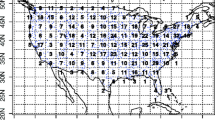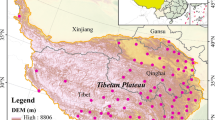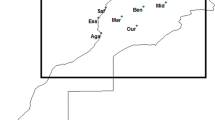Abstract
This paper presents an analysis of the homogenised mean maximum (T max) and minimum (T min) temperatures. The data used in the analysis were collected at eight stations in the Autonomous Province of Vojvodina (Serbia) during the 1949–2008 period. The trends obtained from the slopes of the regression lines using the least square method show 0.9 °C/60 years for T max and 1.1 °C/60 years for T min; the non-parametric Mann–Kendall test was used to determine the statistically significant increasing trends of these two extreme parameters. In this paper, we analyse the influence of the Vangengeim–Girs classification of atmospheric circulation on the T max and T min trends in the Autonomous Province of Vojvodina (Serbia) using linear and quadratic models based on the least square method. Linear stepwise regression and the forward method reveal the highest dependence of T max and T min when the W or E circulation types are included in the model. Non-linear models show a greater contribution of T max and T min at W, E and C circulation types, respectively. The correction of the variance contribution of quadratic models ranges from approximately 16 to 44 % for T max and 32 to 38 % for T min.








Similar content being viewed by others
References
Aguilar E, Auer I, Brunet M, Peterson TC, Wieringa J (2003) Guidelines on climate data and homogenization. Report WMO-TD 1186, WCDMP-No. 53, Geneva, pp 50
Alexander LV, Zhang X, Peterson TC, Caesar J, Gleason B, Klein Tank AMG, Haylock M, Collins D, Trewin B, Rahim F, Tagipour A, Kumar Kolli R, Revadekar JV, Griffiths G, Vincent L, Stephenson DB, Burn J, Aguilar E, Brunet M, Taylor M, New M, Zhai P, Rusticucci M, Luis Vazquez Aguirre J (2006) Global observed changes in daily climate extremes of temperature and precipitation. J Geophys Res 111:D05109. doi:10.1029/2005JD006290
Alexandersson H (1986) A homogeneity test applied to precipitation data. J Clim 6:661–675
Auer I, Böhm R, Scheifinger H, Ungersböck M, Orlik A, Jurkovic A (2004) Metadata and their role in homogenising. Proceedings of the Fourth Seminar for Homogenization and Quality Control in Climatological Databases, WCDMP-No.56, WMO-TD No.1236.17-23, WMO: Geneva, Budapest, Hungary, 6–10 October 2003
Böhm R, Auer I, Brunetti M, Maugeri M, Nanni T, Schöner W (2001) Regional temperature variability in the European Alps: 1760–1998 from homogenized instrumental time series. Int J Climatol 21:1779–1801
Bolotinskaia M, Ryzakov L (1964) Catalogue of macrosinoptic processes according to the classification of Vangengeim 1891–1962. Leningrad, Arkt I Antarkt Nauch Issled, pp 158 (in Russian)
Brázdil R, Budíková M, Faško P, Lapin M (1995) Fluctuation of maximum and minimum air temperatures in the Czech and Slovak Republics. Atmos Res 37:53–65
Brázdil R, Budiková M, Auer I, Böhm R, Cegnar T, Faško P, Lapin M, Gajič-Čapka M, Zaninović K, Koleva E, Niedžwiedž T, Ustrnul Z, Szalai S, Weber RO (1996) Trends of maximum and minimum daily temperatures in Central and Southeastern Europe. Int J Climatol 16:765–782
Brunetti M, Buffoni L, Maugeri M, Nanni T (2000) Trends of minimum and maximum daily temperatures in Italy from 1865 to 1996. Theor Appl Climatol 66:49–60
Cahynová M, Huth R (2009) Changes of atmospheric circulation in central Europe and their influence on climatic trends in the Czech Republic. Theor Appl Climatol 96:57–68
del Río S, Fraile R, Herrero L, Penas Á (2007) Analysis of recent trends in mean maximum and minimum temperatures in a region of the NW of Spain (Castilla y León). Theor Appl Climatol 90:1–12
Domonkos P (1998) Statistical characteristics of extreme temperature anomaly groups in Hungary. Theor Appl Climatol 59:165–179
Domonkos P (2006) Application of objective homogenization methods: inhomogeneities in time series of temperature and precipitation. Időjárás 110:63–87
Domonkos P, Kyselý J, Piotrowicz K, Petrovic P, Likso T (2003) Variability of extreme temperature events in South–Central Europe during the 20th century and its relationship with large-scale circulation. Int J Climatol 23:987–1010
Draper NR (1998) Applied regression analysis. John Wiley & Sons Inc, New York
Drignei D, Forest CE, Nychka D (2008) Parameter estimation for computationally intensive nonlinear regression with an application to climate modeling. Ann Appl Stat 2:1217–1230
Dumanskaya IO, Fedorenko AV (2008) Analysis of the connection of ice cover parameters of the non-Arctic seas in the European part of Russia with global atmospheric processes. Meteorol Gidrol 12:82–95
Easterling DR, Horton B, Jones PD, Peterson TC, Karl TR, Parker DE, Salinger MJ, Razuvayev V, Plummer N, Jamason P, Folland CK (1997) Maximum and minimum temperature trends for the globe. Science 277:364–367
Easterling DR, Meehl GA, Parmesan C, Changnon SA, Karl TR, Mearns LO (2000) Climate extremes: observations, modeling and impacts. Science 289:2068–2074
Founda D, Papadopoulos KH, Petrakis M, Giannakopoulos C, Good P (2004) Analysis of mean, maximum and minimum temperature in Athens from 1897 to 2001 with emphasis on the last decade: trends, warm events and cold events. Global Planet Chang 44:27–38
Hoy A, Jaagus J, Sepp M, Matschullat J (2013a) Spatial response of two European atmospheric circulation classifications (data 1901–2010). Theor Appl Climatol 112:73–88
Hoy А, Sepp М, Matschullat Ј (2013b) Atmospheric circulation variability in Europe and northern Asia (1901 to 2010). Theor Appl Climatol 113:105–126
Hoy А, Sepp М, Matschullat Ј (2013c) Large-scale atmospheric circulation forms and their impact on air temperature in Europe and northern Asia. Theor Appl Climatol 113:643–658
Hoy A, Schucknecht A, Sepp M, Matschullat J (2014) Large-scale synoptic types and their impact on European precipitation. Theor Appl Climatol 116:19–35
IPCC (2007) In: Solomon S, Qin D, Manning M, Chen Z, Marquis M, Averyt KB, Tignor M, Miller HL (eds) Climate change 2007: the physical science basis. Contribution of working group I to the fourth assessment report of the intergovernmental panel on climate change. Cambridge University Press, Cambridge
Jaagus Ј (2006) Climatic changes in Estonia during the second half of the 20th century in relationship with changes in large-scale atmospheric circulation. Theor Appl Climatol 83:77–88
Jaagus J, Post P, Tomingas O (2008) Changes in storminess on the western coast of Estonia in relation to large-scale atmospheric circulation. Clim Res 36:29–40
James PM (2007) An objective classification method for Hess and Brezowsky Grosswetterlagen over Europe. Theor Appl Climatol 88:17–42
Jones PD, Lister DH (2009) The influence of the circulation on surface temperature and precipitation patterns over Europe. Clim Past 5:259–267
Khaliq MN, Ouarda TBMJ (2007) Short communication—on the critical values of the standard normal homogeneity test (SNHT). Int J Climatol 27:681–687
Kozuchowski К, Marciniak К (1988) Variability of mean monthly temperatures and semi-annual precipitation totals in Europe in relation to hemispheric circulation patterns. Int J Climatol 8:191–199
Kuglitsch FG, Toreti A, Xoplaki E, Della-Marta PM, Luterbacher J, Wanner H (2009) Homogenization of daily maximum temperature series in the Mediterranean. J Geophys Res 114:D15108. doi:10.1029/2008JD011606
Lazić L, Savić S, Tomić Ž (2006) Analysis of the temperature characteristics and trends in Novi Sad area (Vojvodina, Serbia). Geogr Pannonica 10:14–21
Luterbacher J, Dietrich D, Xoplaki E, Grosjean M, Wanner H (2004) European seasonal and annual temperature variability, trends, and extremes since 1500. Science 303:1499–1503. doi:10.1126/science.1093877
Milovanović B (2005) Statistical procedure application and results of research of precipitation on mountain Stara Planina. Collect Pap Geogr Inst Jovan Cvijić SASA 54:33–45
Milovanović B (2013) About hidden influence of predictor variables—suppressor and mediator variables. J Geogr Inst Cvijic 63:1–10
Milovanović B, Radovanović M (2009) The connections between solar activity and the circulation of atmosphere in the 1891–2004 period. Collect Pap Geogr Inst Jovan Cvijić SASA 59:35–49
Milovanović B, Radovanović M, Ducić V (2009) Ocean and atmosphere coupling, connection between sub-polar Atlantic air temperature, Icelandic minimum and temperature in Serbia. Glasnik Srpskog Geografskog Društva (Bull Serbian Geogr Soc) 89:165–176, in Serbian; summary on English
Moberg A, Alexandersson H (1997) Homogenization of Swedish temperature data. Part II: homogenized gridded air temperature compared with a subset of global gridded air temperature since 1861. Int J Climatol 17:35–54
Nicholls N, Alexander L (2007) Has the climate become more variable or extreme? Progress 1992–2006. Prog Phys Geog 31:77–87
Pandžić K, Likso T (2009) Homogeneity of average annual air temperature time series for Croatia. Int J Climatol. doi:10.1002/joc.1922
Peterson TC, Easterling DR (1994) Creation of homogeneous composite climatological reference series. Int J Climatol 14:671–679
Salmi T, Määttä A, Anttila P, Ruoho-Airola T, Amnell T (2002) Detecting trends of annual values of atmospheric pollutants by the Mann-Kendall test and Sen’s slope estimates—the excel template application MAKESENS. Finnish Meteorological Institut, Report code FMI-AQ-31, Helsinki, pp 35
Savić S (2009) Analysis of the extreme temperature characteristics in Vojvodina in the period 1951–2000. PhD Dissertation. University of Novi Sad, Faculty of Science, Department of Geography, Tourism and Hotel Management, Novi Sad, pp 272 (in Serbian; summary on English)
Savić S, Petrović P, Milovanović B (2010) Homogenisation of mean air temperature data series from serbia. European Geosciences Union—General Assembly 2010, Vienna, Austria, 02–07 May 2010, Geophysical Research Abstract Vol. 12, EGU2010-5521-1
Schöner W, Auer I, Böhm R, Brunetti M, Maugeri M, Mestre O (2001) Homogenisation and gridding of a Central-European temperature data set. Proceedings of the third seminar for homogenisation and quality control in climatological databases, Hungarian Meteorological Service, Budapest, Hungary, September 2000
Sepp M (2005) Influence of atmospheric circulation on environmental variables in Estonia. PhD Dissertation. Geographicae Universitatis Tartuensis 25, Tartu University Press, pp 85
Sepp M, Jaagus J (2002) Frequency of circulation patterns and air temperature variations in Europe. Boreal Environ Res 7:273–279
Sneyers R (1990) On the statistical analysis of series of observations. WMO, technical note (143). World Meteorological Organisation, Geneve, p 192
Štěpánek P (2005) AnClim - software for time series analysis. Department of Geography, Faculty of Natural Sciences, MU, Brno, 1.47 MB
Tomozeiu R, Busuioc A, Stefan S (2002) Changes in seasonal mean maximum air temperature in Romania and their connection with large-scale circulation. Int J Climatol 22:1181–1196
Tuomenvirta H (2001) Homogeneity adjustments of temperature and precipitation series—Finnish and Nordic data. Int J Climatol 21:495–506
Tuomenvirta H, Alexandersson H, Drebs A, Frich P, Nordli P (2000) Trends in Nordic and Arctic temperature extremes and ranges. J Clim 13:977–990
Türkeş M, Sümer UM, Demir I (2002) Re-evaluation of trends and changes in mean, maximum and minimum temperatures of Turkey for the period 1929–1999. Int J Climatol 22:947–977
Unkašević M, Vujović D, Tošić I (2005) Trends in extreme summer temperatures at Belgrade. Theor Appl Climatol 82:199–205
van den Besselaar EJM, Klein Tank AMG, van der Schrier G (2010) Influence of circulation types on temperature extremes in Europe. Theor Appl Climatol 99:431–439
Vose RS, Easterling DR, Gleason B (2005) Maximum and minimum temperature trends for the globe: an update through 2004. Geophys Res Lett 32:L23822. doi:10.1029/2005GL024379
Yan Z, Jones PD, Davies TD, Moberg A, Bergström H, Camuffo D, Cocheo C, Maugeri M, Demarée GR, Verhoeve T, Thoen E, Barriendos M, Rodriguez R, Martin-Vide J, Yang C (2002) Trends of extreme temperatures in Europe and China based on daily observations. Clim Chang 53:355–392
Acknowledgments
The authors extend their gratitude to the colleagues from the Arctic and Antarctic Research Institute in Saint Petersburg, Russia, for providing the Vangengeim–Girs classification data. We would also like to thank the colleagues from the Meteorological Observatory of the Republic Hydrometeorological Service of Serbia for their kind support in getting metadata records. This research has been funded by the Ministry of Education, Science and Technological Development of the Republic of Serbia through Project Nos. 176020 and III 47007 “Geography of Serbia”.
Author information
Authors and Affiliations
Corresponding author
Rights and permissions
About this article
Cite this article
Savić, S., Milovanović, B., Lužanin, Z. et al. The variability of extreme temperatures and their relationship with atmospheric circulation: the contribution of applying linear and quadratic models. Theor Appl Climatol 121, 591–604 (2015). https://doi.org/10.1007/s00704-014-1263-3
Received:
Accepted:
Published:
Issue Date:
DOI: https://doi.org/10.1007/s00704-014-1263-3




